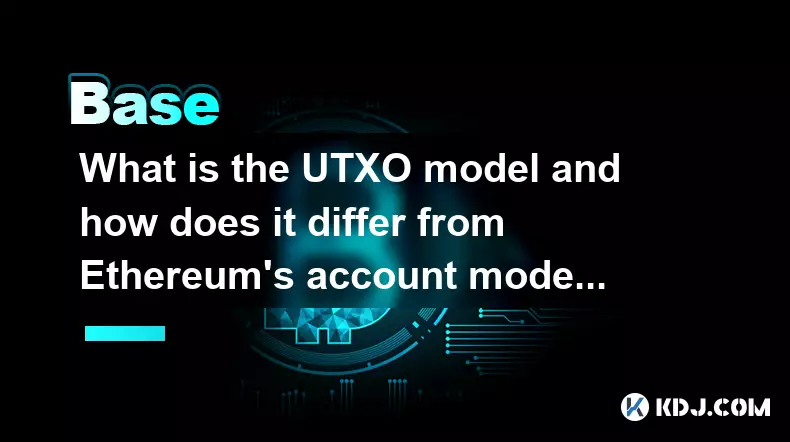-
 bitcoin
bitcoin $105968.894684 USD
4.17% -
 ethereum
ethereum $3639.320047 USD
7.62% -
 tether
tether $1.000339 USD
0.06% -
 xrp
xrp $2.407774 USD
5.96% -
 bnb
bnb $1011.704193 USD
2.28% -
 solana
solana $166.942754 USD
6.37% -
 usd-coin
usd-coin $1.000143 USD
0.03% -
 tron
tron $0.291515 USD
0.25% -
 dogecoin
dogecoin $0.181682 USD
4.06% -
 cardano
cardano $0.585450 USD
4.54% -
 hyperliquid
hyperliquid $42.099968 USD
5.20% -
 chainlink
chainlink $16.160745 USD
5.45% -
 zcash
zcash $645.269648 USD
12.96% -
 bitcoin-cash
bitcoin-cash $507.430338 USD
2.80% -
 stellar
stellar $0.290357 USD
3.69%
What is the UTXO model and how does it differ from Ethereum's account model?
The UTXO model ensures secure, transparent transactions by treating coins as discrete, verifiable outputs, enhancing scalability and privacy in blockchains like Bitcoin.
Nov 10, 2025 at 08:20 am

Understanding the UTXO Model in Blockchain
1. The UTXO (Unspent Transaction Output) model is a fundamental mechanism used by Bitcoin and several other cryptocurrencies to track ownership and validate transactions. Each transaction consumes existing UTXOs as inputs and creates new UTXOs as outputs. These unspent outputs represent available funds that can be spent in future transactions.
2. In this model, every user’s balance is not stored as a single number but derived by scanning the blockchain for all UTXOs linked to their public address. This means wallets must collect and verify multiple UTXOs when constructing a transaction, which increases computational overhead slightly but enhances security and parallelizability.
3. Transactions in the UTXO system are stateless. Each one stands independently and references prior outputs directly. This allows nodes to validate transactions without accessing a global state, making verification more modular and scalable across distributed networks.
4. The structure supports strong privacy features through techniques like CoinJoin and enables efficient light clients via Merkle proofs. Because each output is discrete, users can manage fund granularity with precision, choosing which UTXOs to spend based on fee efficiency or anonymity needs.
5. The immutability and traceability of UTXOs provide a transparent ledger where every coin movement originates from a verifiable source, reinforcing trustless consensus. This design aligns closely with cryptographic principles of digital signatures and hash chains, ensuring tamper resistance at the protocol level.
Ethereum's Account-Based Model Explained
1. Ethereum employs an account-based model, where each user has a balance stored directly within their account on the blockchain state. This resembles traditional banking systems: accounts hold balances that increase or decrease with incoming and outgoing transactions.
2. There are two types of accounts—externally owned accounts (EOAs), controlled by private keys, and contract accounts, governed by code. Both maintain persistent storage and can interact seamlessly within the Ethereum Virtual Machine (EVM).
3. When a transaction occurs, it modifies the global state directly. For example, sending ETH deducts from the sender’s balance and adds to the recipient’s. Smart contract execution can alter multiple accounts’ states simultaneously, enabling complex decentralized applications.
4. Unlike UTXO, this model requires nodes to maintain the entire current state of all accounts, contracts, and storage. While this simplifies balance queries, it increases memory demands and complicates state pruning for full nodes.
5. State transitions are atomic and deterministic, meaning every node computes the same outcome given identical inputs, preserving network consistency even during high-concurrency interactions. This predictability is essential for executing smart contracts reliably across thousands of nodes.
Key Differences Between UTXO and Account Models
1. Data representation differs significantly: UTXO tracks coins as discrete objects, while the account model tracks balances tied to addresses. This affects how wallets calculate available funds and how transactions are structured.
2. Scalability approaches vary. UTXO allows for easier sharding since subsets of UTXOs can be processed independently. Ethereum’s account model faces challenges with cross-shard transactions due to shared state dependencies.
3. Privacy capabilities favor UTXO because users can generate new addresses per transaction and mix UTXOs without revealing linkages. In contrast, account models expose all transaction history linked to an address, reducing pseudonymity.
4. Smart contract functionality integrates more naturally with account-based systems. Ethereum leverages its global state to enable contracts that persist data and respond to messages, whereas UTXO-based platforms require extensions like script logic or sidechains to support similar functionality.
5. Transaction fees and resource management also diverge—UTXO systems often base fees on data size, while Ethereum uses gas pricing tied to computational complexity, reflecting deeper integration between execution and economic incentives.
Common Questions About UTXO and Account Models
What prevents double-spending in the UTXO model?Double-spending is prevented because each UTXO can only be consumed once. Once included as an input in a valid transaction, it is marked as spent and cannot be reused. Nodes reject any attempt to reference already-spent outputs, enforcing integrity through consensus rules.
How does Ethereum handle concurrent transactions affecting the same account?Ethereum orders transactions using nonces—sequential numbers attached to each transaction from an EOA. Nodes process transactions in nonce order, preventing race conditions. If two transactions have the same nonce, only the first confirmed will be accepted, discarding the other.
Can UTXO blockchains support smart contracts?Yes, though with limitations compared to account-based systems. Platforms like Cardano and Ergo extend UTXO with scripting languages to enable conditional spending and decentralized logic. These models treat contracts as constraints on redemption rather than persistent stateful entities.
Why do some developers prefer the UTXO model for Layer-2 solutions?The UTXO model’s stateless nature makes it ideal for off-chain protocols like payment channels. Since each output is self-contained, parties can exchange signed transactions off-chain and settle final states on-chain without maintaining continuous connectivity or shared context.
Disclaimer:info@kdj.com
The information provided is not trading advice. kdj.com does not assume any responsibility for any investments made based on the information provided in this article. Cryptocurrencies are highly volatile and it is highly recommended that you invest with caution after thorough research!
If you believe that the content used on this website infringes your copyright, please contact us immediately (info@kdj.com) and we will delete it promptly.
- XRP: Is This Crypto's Best-Performing Asset?
- 2025-11-11 06:45:01
- AVAX & OP: Price Prediction, Open Interest, and Recovery Gains - What's Next?
- 2025-11-11 06:50:02
- Mantle, Anchorage Digital, and Institutional Custody: Bridging TradFi and DeFi
- 2025-11-11 05:20:01
- XRP ETF Hype and Remittix Rise: Navigating the Evolving Crypto Landscape
- 2025-11-11 05:25:01
- UK Stablecoin Regulation: A Pivotal Step Forward?
- 2025-11-11 05:05:01
- DOT Price Eyes Breakout Amid Bitcoin Rally: A Polkadot Deep Dive
- 2025-11-11 05:35:01
Related knowledge

What is the difference between a transparent and a shielded transaction?
Nov 10,2025 at 05:59pm
Understanding Transparent Transactions in Cryptocurrency1. Transparent transactions are the standard form of transaction on most public blockchains li...

What is a "crypto airdrop farmer" and what strategies do they use?
Nov 09,2025 at 03:39pm
What Is a Crypto Airdrop Farmer?1. A crypto airdrop farmer is an individual who actively participates in blockchain projects to qualify for free token...

How does a crypto insurance protocol work?
Nov 08,2025 at 12:39am
Understanding Crypto Insurance Protocols1. A crypto insurance protocol operates by offering financial protection against losses incurred from digital ...

What is token composability and why is it called "DeFi Legos"?
Nov 09,2025 at 06:39am
Bitcoin's Role in Decentralized Finance1. Bitcoin remains the cornerstone of decentralized finance, serving as a benchmark for value and trustlessness...

What is an "exploit" versus a "hack" in the context of smart contracts?
Nov 09,2025 at 12:40am
Understanding Exploits in Smart Contracts1. An exploit refers to the utilization of a known vulnerability within a smart contract’s code to gain unint...

What is a decentralized storage network and how does it compare to cloud services?
Nov 07,2025 at 11:59pm
Understanding Decentralized Storage Networks1. A decentralized storage network distributes data across a peer-to-peer infrastructure rather than relyi...

What is the difference between a transparent and a shielded transaction?
Nov 10,2025 at 05:59pm
Understanding Transparent Transactions in Cryptocurrency1. Transparent transactions are the standard form of transaction on most public blockchains li...

What is a "crypto airdrop farmer" and what strategies do they use?
Nov 09,2025 at 03:39pm
What Is a Crypto Airdrop Farmer?1. A crypto airdrop farmer is an individual who actively participates in blockchain projects to qualify for free token...

How does a crypto insurance protocol work?
Nov 08,2025 at 12:39am
Understanding Crypto Insurance Protocols1. A crypto insurance protocol operates by offering financial protection against losses incurred from digital ...

What is token composability and why is it called "DeFi Legos"?
Nov 09,2025 at 06:39am
Bitcoin's Role in Decentralized Finance1. Bitcoin remains the cornerstone of decentralized finance, serving as a benchmark for value and trustlessness...

What is an "exploit" versus a "hack" in the context of smart contracts?
Nov 09,2025 at 12:40am
Understanding Exploits in Smart Contracts1. An exploit refers to the utilization of a known vulnerability within a smart contract’s code to gain unint...

What is a decentralized storage network and how does it compare to cloud services?
Nov 07,2025 at 11:59pm
Understanding Decentralized Storage Networks1. A decentralized storage network distributes data across a peer-to-peer infrastructure rather than relyi...
See all articles























![🔥 Long awaited! The ancestor of Pi coin is about to take off? PI friends, come in and take a look! [Daily Coin Selection | Bitcoin Trend | Money Making Opportunities] 🔥 Long awaited! The ancestor of Pi coin is about to take off? PI friends, come in and take a look! [Daily Coin Selection | Bitcoin Trend | Money Making Opportunities]](/uploads/2025/11/10/cryptocurrencies-news/videos/6911e42f9bad7_image_500_375.webp)


















































